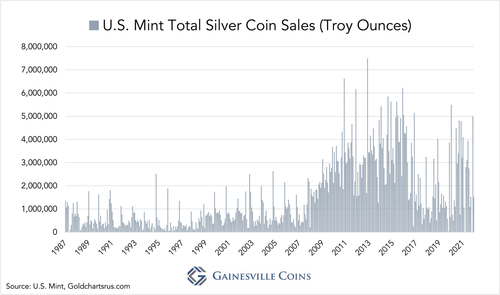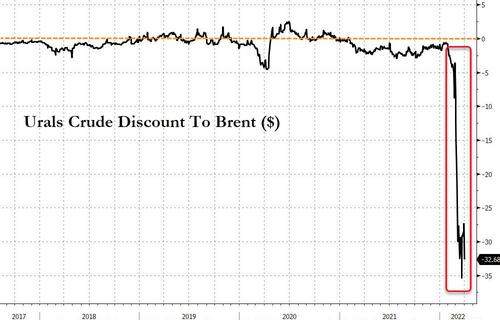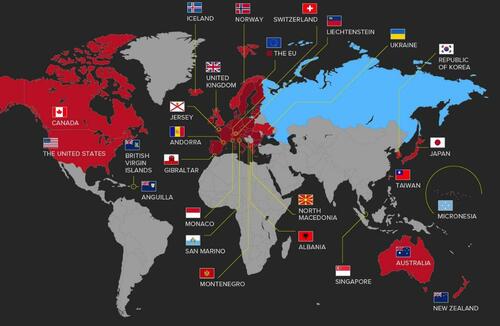Authored by Soeren Kern via The Gatestone Institute,
-
The goal is “strategic autonomy” — the ability for the EU to act independently of, and as a counterweight to, the United States and the North Atlantic Treaty Organization — in matters of defense and security.
-
The key component of the Strategic Compass is the development of a so-called EU Rapid Deployment Capacity (RDC), a military force able to intervene in “non-permissive environments” anywhere in the world.
-
The RDC is to become fully operational by 2025 and commanded by an institution called the “EU Military Planning and Conduct Capability.” (The term “capability” is a politically correct substitute for “headquarters,” as in “military headquarters.”)
-
The push for Europe to achieve strategic autonomy from the United States is being spearheaded by Macron, who, as part of his reelection campaign, apparently hopes to replace former German Chancellor Angela Merkel as the de facto leader of Europe.
-
The danger is that many of the pie-in-the-sky policy proposals in the Strategic Compass will divert and drain resources and finances from where they are actually needed: NATO.
-
A logical course of action would be for EU member states to honor past pledges to increase defense spending as part of their contribution to the transatlantic alliance. That, however, would fly in the face of the folie de grandeur — the delusions of grandeur — of European federalists who dream of transforming the EU into a geopolitical “great power.”
The European Union has published a new strategy aimed at transforming the 27-member bloc into an independent geopolitical actor on the world stage.

The long-awaited “Strategic Compass” lays out an ambitious ten-year plan for the EU to develop an autonomous European security architecture. The goal is “strategic autonomy” — the ability for the EU to act independently of, and as a counterweight to, the United States and the North Atlantic Treaty Organization — in matters of defense and security.
The greatest advocate of strategic autonomy, French President Emmanuel Macron, said the objective is to make Europe “powerful in the world, fully sovereign, free in its choices and master of its destiny.”
In fact, dreams of strategic autonomy have been waylaid by reality. Russia’s invasion of Ukraine has underscored the indispensability of the United States and NATO for European defense and security. In the face of Russian revanchism, most EU member states can be expected to oppose efforts to develop an independent European military capacity that undermines the transatlantic alliance.
The 64-page policy blueprint — “A Strategic Compass for Security and Defense” — was originally commissioned in June 2020 by the government of former German Chancellor Angela Merkel. An initial draft of the document, presented in November 2021, was significantly revised after EU member states were given the opportunity to submit requests for changes. The document was then hastily rewritten after Russia invaded Ukraine in February 2022.
The 2022 Strategic Compass — which builds on the 2003 European Security Strategy, the 2016 Global Strategy, the 2020 EU Security Union Strategy and the 2022 Versailles Declaration — aims to “translate” the “common ambition” of European strategic autonomy “into actionable proposals.”
The document, which has been described as “a master military strategy document” and “the closest thing the EU could have to a military doctrine,” seeks to “build a common strategic culture” to “contribute to the EU’s credibility as a strategic actor.”
The Strategic Compass, also described as “an expression of Franco-German cooperation,” is loaded with lofty rhetoric: “Europe’s geopolitical awakening,” “permanent strategic posture,” “instruments of power,” “weaponization of interdependence,” “the return to power politics,” “full spectrum of threats,” “strategic convergence,” “common strategic culture,” “learning to speak the language of power,” “quantum leap forward on security and defense,” and “shape the global future,” among many others.
The key component of the Strategic Compass is the development of a so-called EU Rapid Deployment Capacity (RDC), a military force able to intervene in “non-permissive environments” anywhere in the world. (The term “capacity” is a politically correct substitute for the word “force,” apparently to avoid giving the impression that the EU is seeking to build an army.)
The document calls for the EU to be able to quickly deploy up to 5,000 troops — including land, air, and maritime components — for “crisis management missions” outside the bloc. The RDC is to become fully operational by 2025 and commanded by an institution called the “EU Military Planning and Conduct Capability.” (The term “capability” is a politically correct substitute for “headquarters,” as in “military headquarters.”)
On March 21, the day the Strategic Compass was published, Germany’s hapless defense minister, Christine Lambrecht, announced that Germany would provide the entire 5,000-strong force plus heavy equipment for the RDC’s first year. She was forced to backtrack after learning that the German military is so understaffed and underequipped that it is incapable of delivering that amount of personnel and equipment. The German Defense Ministry later clarified that Germany would supply a “core” of between 1,500 and 2,000 troops.
The RDC concept — widely viewed as the foundation of a future supranational EU Army — replaces the existing EU Battlegroup concept. Created in 2007, EU battlegroups, battalion-sized formations consisting of 1,500 troops each, are paper tigers. They have never been deployed due to disputes over when and where they should be used, and over funding. The Strategic Concept does not explain why the EU thinks the RDC will succeed where the EU Battlegroup concept has failed.
Another key element of the Strategic Compass involves implementation of Article 44 of the Lisbon Treaty (aka the European Constitution) which allows the EU to circumvent the unanimous consent principle during crises. The Strategic Compass states that the EU will “decide on practical modalities” for implementing Article 44, which has never been used.
In practical terms, Article 44 would allow the EU to launch EU-flagged missions and operations without the consent of all 27 EU member states. In effect, such “coalitions of the willing” would be a back-door way for EU member states, such as France and Germany, to move ahead with military integration regardless of opposition from other EU members, such as those from Eastern Europe. Implementation of Article 44 will probably move forward during the French EU Presidency in the first half of 2022.
The Strategic Compass also calls for:
-
Creating an “EU Hybrid Toolbox” to respond to “a broad range of hybrid threats.” A “Hybrid Fusion Cell” aims to provide “foresight and situational awareness” while a “dedicated toolbox” will “address foreign information manipulation and interference.”
-
Further developing the “EU Cyber Defense Policy” to be “better prepared for and respond to cyberattacks.” A new “Cyber Resilience Act” aims to “increase our common approach to cyber infrastructure.”
-
Expanding the “Coordinated Maritime Presences” to the Indo-Pacific.
-
Developing an “EU Space Strategy” for security and defense.
-
Implementing a “Climate Change and Defense Roadmap.”
-
Creating a “Defense Innovation Hub” within the European Defense Agency.
The document further seeks to: “fill strategic gaps,” “reduce technological and industrial dependencies,” “promote rapid and more flexible decision-making processes,” “strengthen command and control structures,” “increase readiness and cooperation,” “ensure greater financial solidarity,” “spend more and better in defense,” “develop cutting-edge military capabilities,” and “invest in technological innovation for defense.”
In all, the Strategic Compass includes more than 40 goals in four “work strands” — “Act,” “Secure,” “Invest,” and “Partner” — that are to be implemented by 2030.
The EU’s foreign policy chief, Josep Borrell, described the Strategic Compass as “a turning point for the European Union as a security provider and an important step for the European security and defense policy.” He added: “This is only the beginning.”
Impact on NATO
A key unanswered question is how the Strategic Compass will impact NATO, the only credible guarantor of European security. The EU’s foreign policy chief, Josep Borrell, in a forward to the report, pledged that a stronger EU will “strengthen NATO” and be a “stronger transatlantic partner.” Indeed, the document stresses the complementarity between the EU and NATO.
The aim of EU strategic autonomy, however, is evidently to push the United States out of Europe so that the EU can assume its role as a “strategic power” and an independent pole in a “contested multipolar world.”
The push for Europe to achieve strategic autonomy from the United States is being spearheaded by Macron, who, as part of his reelection campaign, apparently hopes to replace former German Chancellor Angela Merkel as the de facto leader of Europe.
Macron, who claims that NATO is “brain dead,” argues that Europe needs its own military because, according to him, the United States is no longer a reliable ally. He cites as examples: U.S. President Joe Biden’s precipitous withdrawal of American troops from Afghanistan; the growing pressure on Europe to take sides with the United States on China; and France’s exclusion from a new security alliance in the Indo-Pacific region.
Even before Russia invaded Ukraine, many EU member states disagreed with Macron. Eastern European countries know that neither the EU nor France can match the military capabilities offered by NATO and the United States. Other countries are concerned about a panoply of issues ranging from financial costs to national sovereignty. Still others are opposed to creating a parallel structure to NATO that could undermine the transatlantic alliance.
Many EU countries insist on respecting former U.S. Secretary of State Madeleine Albright’s famous “three Ds“: no decoupling of European security from the United States and NATO; no duplicating capabilities and structures that already exist within NATO; and no discriminating against NATO members that are not members of the EU.
The danger is that many of the pie-in-the-sky policy proposals in the Strategic Compass will divert and drain resources and finances from where they are actually needed: NATO.
Case in point: NATO already has a rapid reaction force. The so-called NATO Response Force can deploy 40,000 troops (eight times more than the EU’s proposed rapid reaction force) that are drawn from the same European militaries that the EU wants to use (21 EU member states are also members of NATO). If the EU’s real concern is about security, why would it be trying to duplicate existing NATO capabilities?
A logical course of action would be for EU member states to honor past pledges to increase defense spending as part of their contribution to the transatlantic alliance. That, however, would fly in the face of the folie de grandeur — the delusions of grandeur — of European federalists who dream of transforming the EU into a geopolitical “great power.”
Evaluating the Strategic Concept
In an analysis — “The EU’s Strategic Compass: Brand New, Already Obsolete” — Nick Witney, a senior policy fellow with the pro-EU European Council on Foreign Relations, wrote:
“The product of many months of debate in Brussels, this effort to align the strategic thinking of 27 member states, each with its own foreign and defense policies, was meant to be a foundational document for a geopolitical EU. But, as a strategy conceived and largely drafted in the days before Russian President Vladimir Putin changed the world, the Strategic Compass has simply been overtaken by events….
“The Compass itself is full of the usual process-heavy gradualism, to be implemented over a decade and wrapped in conventional reflections on the dangerous world we live in and the ever-popular bromides about the EU’s need to ‘partner’ with all and sundry….
“What really dooms the operational side of the Compass’s agenda is, of course, the same thing that has crimped the EU’s military aspirations from the beginning — the reluctance of top brass across Europe to take the enterprise seriously. NATO has always been where ‘serious’ military business is done, where they rub shoulders with (and are told what to do by) the mighty United States. The notion of EU intervention operations seems, by contrast, both amateurish and risky without the US to back them up. Now that NATO is rejuvenated and overhauling its whole defensive posture against Russia, no one will rush to stand up a new EU force.”
In an interview with Euronews, Isabella Antinozzi, an analyst with the European Council on Foreign Relations, noted:
“The document devotes barely a line to outlining cooperation with the UK — which is striking considering how much of a key partner the UK is on matters of security and defense. This is, to me, a clear sign that relations between London and Brussels are completely strained.”
In an essay — “Grand Illusions: Partnerships in the EU’s Strategic Compass” — Antinozzi added:
“It is important for the EU to recognize that excluding the UK from European defense is likely to be both unrealistic and counterproductive. As such, any mixed feelings and wider political tensions associated with Brexit should now give way to constructive defense dialogue between the sides….
“Security and defence are versatile policy areas with the potential to help rebuild trust between London and Brussels. And ad hoc cooperation in these realms could provide a foundation for a better political relationship in the future.”
In an analysis — “Does the Strategic Compass Herald a Stronger EU in Security and Defense?” — Luigi Scazzieri, an analyst with the Center for European Reform, wrote:
“The Strategic Compass is unlikely to end transatlantic and European debates about the EU’s role in European security…. The EU’s ambitions to be a military player endure and could create friction between EU member-states and the U.S., and within Europe, if they lead to competition for resources and personnel with NATO. There may also be disagreements if the EU expands its investments in defense capabilities, as funds would almost certainly be tied to strengthening the EU defense industry and therefore buying European rather than US equipment.”
The Brussels-based Center for European Policy Studies published an 11-page report — “The EU’s Strategic Compass: A Guide to Reverse Strategic Shrinkage?” — which concluded:
“The text has been substantially rewritten in the last month to emphasize the impact of Russia’s war of aggression against Ukraine, revealing a newfound consensus on the danger Russia poses but also a lack of strategic foresight. This raises the question of whether the final document might contain shortcomings that could prove to be fatal. As it stands, the Strategic Compass may now be lopsided, downplaying the threat posed by China to the multilateral rules-based order vouched for by the EU and, despite being the talk of Brussels in 2021, the relevance to Europe of what will surely be the center of gravity in the 21st century: the Indo-Pacific. As such, the document essentially characterizes the EU’s security and defense ambitions as that of regional — not a global — power.”











